
Solaia - by Piero Antinori 2007
Log in to view pricing and order online
Don't have an account? Register here
Item# 83116A-07/1PK
James Suckling
97pt
Vinous Media
97pt
Wine Spectator
94pt
Wine Advocate
97pt
